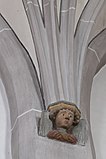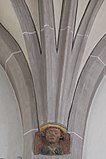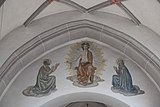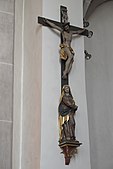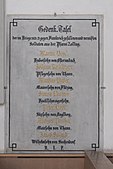St. Johannes Baptist (Zolling)
St. Johannes Baptist is the Catholic parish church of Zolling in the Upper Bavarian district of Freising . The church is one of the protected architectural monuments in Bavaria.
history
The first mention of a church in Zolling dates from the year 804 , when a Wolfheri from Haag an der Amper bought his property from the “House of St. Mary and St. Peter ”gave. It is not known when the patronage passed to John the Baptist . It is believed that the Zolling parish had a small baptistery right next to the Amper , which was consecrated to John the Baptist, in order to exercise the right to baptize . After this chapel fell into disrepair, the baptism was probably moved to the main church and therefore the patronage changed.
Today's parish church was built in the second half of the 15th century under Pastor Konrad Rothenpeck. The eastern, low choir was built in front of the high nave . The base of the church tower probably also dates from this time. The day of dedication of the church was probably the feast of the Apostle Bartholomew on August 24th. There is evidence that the church had four altars in 1540 . A clock and bell were also purchased.
During the Thirty Years War , the tower, which still had its Gothic pointed helmet, was destroyed by the Swedes on a Saturday lunchtime in 1632. In commemoration of the destruction of the tower in Zolling ringing bells Saturdays already at 13 o'clock after work, even though that in the region Feierabend ringing Saturdays normally heard at 15 o'clock. The tower was repaired in 1718 and 1784. It probably got its present Rococo structure in the middle of the 18th century. The builder of the tower is not known. Further repairs to the tower took place in 1824, 1892, 1925, 1956, 1967 and 1983. This is evidenced by inscriptions in the tower room.
In 1862 the two-story sacristy was added to the southern choir corner .
Exterior construction
Because of the mighty, 56-meter-high tower attached to the west facade, the church is popularly referred to as the Cathedral of the Ampertal . The substructure of the tower, which towers above the nave, goes back to the Gothic church building. This can be seen from the pointed arch panels and the pointed arch window on the north side above the main portal. A white and pink painted octagon in the Rococo style is placed on the substructure, which is crowned by a copper dome and a lantern with a double cross. The shape of the cross probably comes from the Scheyr cross relic . The bell storey is pierced on all four sides by arched sound windows with wooden sound lamellas. Small cross-oval openings are cut on three sides, on the west side this is only painted on. The tower clock, which was last renewed in 1983, is installed under the roof. The dials have a diameter of two meters.
The approximately 18 meter long nave has three pointed arch windows on each side and clearly towers above the choir. The outer walls of the nave are reinforced by triple-stepped buttresses, and at the choir with double-stepped buttresses.
inner space
The interior is entered through a vestibule on the first floor of the tower. On the west side of the nave there is a double gallery on four wooden pillars , on the upper floor of which the organ is housed. The single nave, divided by three window axes , is covered by a ribbed vault like the choir . The keystones are decorated with the symbols of the four evangelists and John the Baptist, in the choir with the symbols of the Trinity , the eye of God , the lamb , the dove of the Holy Spirit and the Zollinger coat of arms. The gray-framed vault ribs rest in the choir on stone consoles , some of which are sculpted as angel heads. The retracted choir, closed on three sides, is raised by two steps and divided into two axes.
At the transition from the nave to the choir, wall paintings can be seen, on which Jesus is shown in the middle and Mary and the apostle Peter to the side, reminding of the former patronage of the church.
Leaded glass window
Saint Notburga , the patron saint of maidservants, and Saint Wendelin , the patron saint of shepherds, farmers and farm workers, are depicted on the two leaded glass windows in the choir .
Gallery pictures
The pictures on the gallery parapet, which were created by Josef Anton Niggl in the first half of the 18th century, date from the Baroque period. The 18 pictures show God the Father , John the Baptist, Jesus, Mary, the Evangelists and the Apostles . Until the renovation in 1996, the pictures were framed in powerful black with fine gold chasing, since then the parapets have been painted white.
Altars
The three neo-Gothic altars in the church date from 1866. Like the pulpit, which is no longer preserved, they were created by Anselm Sickinger from Munich.
High altar
The high altar is a winged altar and like the two side altars in red and gold. The focal point under the carved neo-Gothic bursts is the group of figures depicting the baptism of Jesus , in which John the Baptist baptizes the kneeling Savior in the Jordan. The Holy Spirit and God the Father hover over the scene in the form of a dove. The latter is visible with both open and closed sashes. The apostles Peter with the key (left) and Paul with the sword (right), which can also only be seen with the wings closed, stand in side niches , and above the Saint Barbara with the chalice and tower (left) and Saint Catherine with them Sword and straightening wheel (right). The relief carvings on the inside of the wings depict the sermon and the decapitation of John the Baptist. The back of the wings, which can only be seen during Lent , show the symbols of the Passion of Jesus.
Below the altar wing there is a golden aedicule , which usually shows a cross. The monstrance with the host is exhibited here at worship festivals . The aedicula is flanked by two kneeling angels designed as candlesticks.
There is a relief carving on the front of the cafeteria showing Jesus breaking bread during the Last Supper . In the cafeteria is the tabernacle , on the golden doors of which there are pictures of wheat ears embossed in silver.
Side altars
The left side altar is dedicated to Mary, who is depicted as the Madonna of the protective cloak. The identity of the remaining characters is not known. In the lower part of the altar two angels show the handkerchief with the face of Jesus. During Holy Week, the Holy Thursday altar is set up here, in which the Holy of Holies is kept until Easter Vigil.
The right side altar is dedicated to St. Francis Xavier , who is highly venerated in Bavaria and whose brotherhood has existed in Zolling since 1733.
People's altar and ambo
The altar of the Zollingen church was replaced together with the ambo in the course of the redesign in 1996 . Both are made of reddish limestone from the Berchtesgaden area, which blends harmoniously into the overall picture of the parish church. The altar bears a golden lamb embedded on the front, the ambo bears a gilded book cover, which is carried by the four evangelists on the raised side. Cardinal Friedrich Wetter consecrated the popular altar during Confirmation in 1996.
Former altarpieces
In its baroque design, the Zollingen parish church had six altars, of which only the altarpieces are preserved today. Two of these former altarpieces by Philipp Jakob Greil from 1750 hang in the choir: The Adoration of the Magi and Jesus in the Temple .
In the north nave hangs in a valuable baroque frame the altar painting The Baptism of Jesus from the former main altar, created in 1661 by Johann Christoph Schauer, and next to it the painting The Beheading of John painted and signed by the electoral court painter Johann Kaspar Sing in 1724 .
A former baroque altarpiece, The Death of St. Franz Xaver . This picture was created by Lorenz Peter Herdegen in 1733.
The second picture of the Xaveri brotherhood is of art historical value. You can see a pilgrimage to Zollinger Church, which is shown in its old form with a pointed roof on the tower. This is the only image of the old tower. It can also be concluded from this picture that there was a pilgrimage to St. Francis Xavier in Zolling at that time. Above the supplication, the saint can be seen, who sits on the right hand of the Holy Trinity and directs the blessing of the Holy Spirit on the pilgrimage.
Further equipment
A pietà from the 17th century stands under the gallery on the south side . The creator, as well as that of the Gothic cross with the Mother of Sorrows, which hangs on the left pillar of the choir, is unknown.
The fallen of the parish are commemorated in the nave with three stone tablets. Mathias Mayr, captain in the Tattenbach regiment of Bavarian patriots, who led them in the Sendling Christmas Murder Christmas in 1705, received his own memorial stone .
organ
The organ of the Zollingen parish church was built in 1997 by the Jann company in Allkofen. It has 1172 pipes made of wood and metal, these are distributed over 17 registers and a deduction. The longest pipe is 2.41 meters long. The organ is played on two manuals.
The organ, which, in contrast to its predecessor, is optically based on the altars of the church, was partly financed by the sale of the pipes of the old organ and a cookbook, for which many well-known Zollinger recipes have contributed.
Bells
The three bells of the Zollingen parish church hang in a steel belfry. After two of the three existing bells had to be handed in during the First World War , a new, complete bell was purchased in 1924 and the remaining bell was sold.
The three new bells were cast by the Bochumer Verein and are relatively large, none of which are less than a meter in diameter. The diameter of the largest bell is 1.44 meters, making it the third largest in the Moosburg deanery after the Kastulus bell in Moosburg and a bell in Nandlstadt .
Priest's grave
The priest's grave is on the north side of the tower. After it was covered relatively inconspicuously with the same tiles as the path until the death of the cleric councilor Herrmann Kneidinger and was only noticeable by the memorial stones in the wall niche, it was redesigned on the initiative of the municipal council to honor the Zollinger honorary citizen. The crypt is now covered by a granite slab that is set off from its surroundings by chains. The memorial stones of the people buried in the priest's grave are located in a niche in the tower.
graveyard
The church is surrounded on all sides by a cemetery . This was expanded in 1982, 1990 and 2009. During the renovation in 2009, an urn wall was also built so that urn burials can also be carried out in the future.
Morgue
The morgue is east of the church. Next to the funeral hall there is a figure of Our Lady of Sorrows.
literature
- Josef Brückl, Adolf Widmann: Zolling. A municipality in the Ampertal . Zolling community (ed.), Freisinger Druck, Freising 1994.
- Friedrich Keydel: The churches of the parish St. Johannes Baptist Zolling . Zolling Catholic Parish Office (ed.), Bauer-Verlag, Thalhofen 2008, ISBN 978-3-941013-13-1 .
- Georg Völkl: The place names of the Freising country . Frisinga, Volume 46, No. 1, 1963.
Web links
- Parish Church of St. John the Baptist, Zolling Parish Association in the Archdiocese of Munich and Freising
Individual evidence
- ↑ List of monuments for Zolling (PDF) at the Bavarian State Office for Monument Preservation, monument number D-1-78-157-1
- ^ Brückl / Widmann: Zolling. A municipality in the Ampertal . Freising 1994, p. 352
- ^ Brückl, Widmann: Zolling. A municipality in the Ampertal . Freising 1994, p. 320
- ^ Brückl / Widmann: Zolling. A municipality in the Ampertal . Freising 1994, p. 324
- ^ Brückl / Widmann: Zolling. A municipality in the Ampertal . Freising 1994, p. 316.
- ↑ The new Jann organ , Festschrift. Freising 1996
- ^ Brückl / Widmann: Zolling. A municipality in the Ampertal . Freising 1994, p. 327f
Coordinates: 48 ° 26 ′ 59.3 " N , 11 ° 46 ′ 15.3" E





